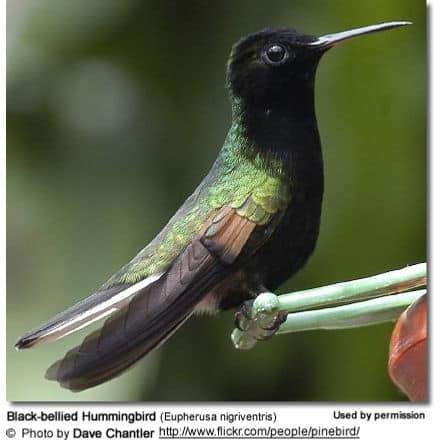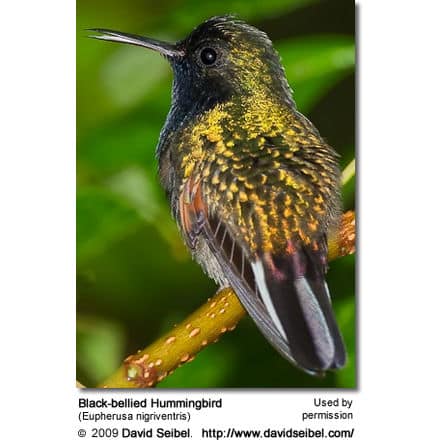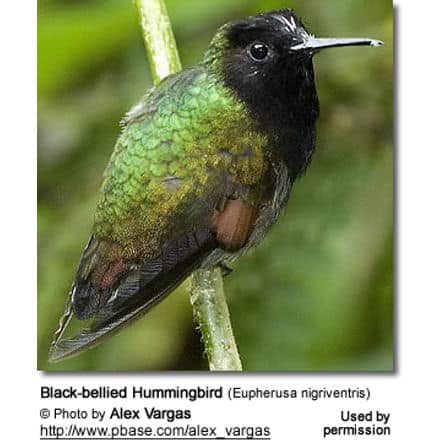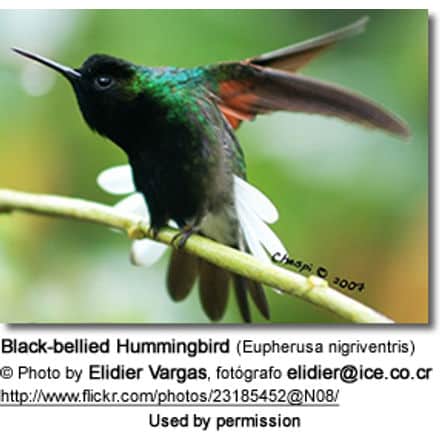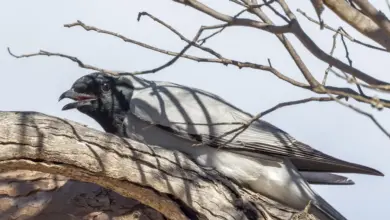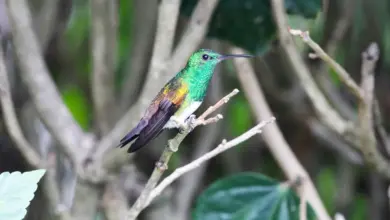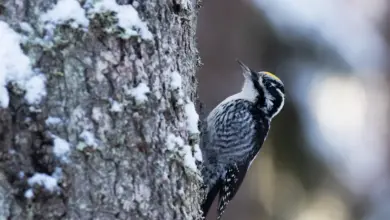Black-bellied Hummingbirds (Eupherusa nigriventris)
Black-bellied Hummingbirds
Hummingbird Information
The Black-bellied Hummingbird (Eupherusa nigriventris) is a Central American found in moist forests and edge at middle elevations on the Caribbean slope from central Costa Rica to western Panama
Alternate (Global) Names:
Spanish: Colibrí de Vientre Negro, Colibrí Pechinegro, Colibrí pechinero, Colibrí Ventrinegro … Italian: Colibrì pancianera, Colibrì ventrenero … French: Colibri à ventre noir … German: Schwarzbaucheupherusa, Schwarzbauch-Eupherusa, Schwarzbauchkolibri … Czech: Kolibrík kostarický, kolib?ík kostarický … Danish: Sortbuget Kolibri …Finnish: Surukolibri … Japanese: kuroharaojirohachidori … Dutch: Zwartbuikkolibrie … Norwegian: Svartbrystkolibri … Polish: diamencik czarnobrzuchy … Russian: ??????????? ???????? … Slovak: kolibrík ciernobruchý … Swedish: Svartbukad kolibri
Description:
The Black-bellied Hummingbird male has a velvet black face mask, throat and belie, and light-colored under tail feathers. The upper plumage is iridescent golden-green. The bend of his wings are rusty-colored. He has a black, long, slightly curved beak.
The female is green above and pale-colored above. She doesn’t have the black markings of the male.
These birds were named for the humming sounds created by the beat of their wings, which make up to 100 beats per second. Their wings move so rapidly that the naked eye cannot detect them. They are the only birds that can generate power on both the forward and backward wing strokes, which makes it possible for them to fly backward.
Nesting / Breeding
Hummingbirds are solitary in all aspects of life other than breeding; and the male’s only involvement in the reproductive process is the actual mating with the female. They neither live nor migrate in flocks; and there is no pair bond for this species. Males court females by flying in a u-shaped pattern in front of them. He will separate from the female immediately after copulation. One male may mate with several females. In all likelihood, the female will also mate with several males. The males do not participate in choosing the nest location, building the nest or raising the chicks.
The female Black-bellied Hummingbird is responsible for building the bulky cup-shaped nest out of plant fibers woven together and green moss on the outside for camouflage in a protected location, typically about 2 – 4 m high at the end of a descending bamboo stem or on a rootlet under a bank. She lines the nest with soft plant fibers, animal hair and feather down, and strengthens the structure with spider webbing and other sticky material, giving it an elastic quality to allow it to stretch to double its size as the chicks grow and need more room. The nest is typically found on a low, thin horizontal branch.
The average clutch consists of two white eggs, which are about the size of coffee beans. She incubate the eggs for about 15 to 19 days. The male is not involved in this process. He continues to defend his territory and the flowers he feeds on. The female is the only care taker. She alone protects and feeds the young with regurgitated food (mostly insects since nectar is an insufficient source of protein for the growing chicks). As is the case with other hummingbird species, the chicks are brooded only the first week or two, and left alone even on cooler nights after about 12 days – probably due to the small nest size. The juveniles leave the nest when they are about 20 to 26 days old.
Diet / Feeding
The Black-bellied Hummingbird primarily feed on nectar taken from a variety of brightly colored, scented small flowers of trees, herbs, shrubs and epiphytes.
They favor flowers with the highest sugar content (often red-colored and tubular-shaped) and seek out, and aggressively protect, those areas containing flowers with high energy nectar. They use their long, extendible, straw-like tongues to retrieve the nectar while hovering with their tails cocked upward as they are licking at the nectar up to 13 times per second. Sometimes they may be seen hanging on the flower while feeding.
Many native and cultivated plants on whose flowers these birds feed heavily rely on them for pollination. The mostly tubular-shaped flowers actually exclude most bees and butterflies from feeding on them and, subsequently, from pollinating the plants.
They may also visit local hummingbird feeders for some sugar water, or drink out of bird baths or water fountains where they will either hover and sip water as it runs over the edge; or they will perch on the edge and drink – like all the other birds; however, they only remain still for a short moment.
They also take some small spiders and insects – important sources of protein particularly needed during the breeding season to ensure the proper development of their young. Insects are often caught in flight (hawking); snatched off leaves or branches, or are taken from spider webs. A nesting female can capture up to 2,000 insects a day.
Males establish feeding territories, where they aggressively chase away other males as well as large insects – such as bumblebees and hawk moths – that want to feed in their territory. They use aerial flights and intimidating displays to defend their territories.
Males are fiercely territorial. Aerial battles between males are frequently observed and are usually very entertaining to the observer. Even though males will defend the flowers and scrubs in their feeding territories against other male hummingbirds; they usually tolerate females.
Metabolism and Survival and Flight Adaptions – Amazing Facts
Call / Vocalization:
The call is a high-pitched twittering.
Species Research by Sibylle Johnson
Please Note: The articles or images on this page are the sole property of the authors or photographers. Please contact them directly with respect to any copyright or licensing questions. Thank you.

